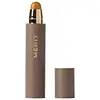Typology Tinted Concealer Versus Merit Beauty The Minimalist Perfecting Complexion Foundation and Concealer Stick
What's inside
What's inside
 Key Ingredients
Key Ingredients

 Benefits
Benefits

 Concerns
Concerns

 Ingredients Side-by-side
Ingredients Side-by-side

Water
Skin ConditioningCoco-Caprylate/Caprate
EmollientJojoba Esters
EmollientCentaurea Cyanus Flower Water
Skin ConditioningTri (Polyglyceryl-3/Lauryl) Hydrogenated Trilinoleate
EmulsifyingSilica
AbrasiveCaffeine
Skin ConditioningNiacinamide
SmoothingMagnesium Sulfate
Cetyl Alcohol
EmollientSodium Benzoate
MaskingPotassium Sorbate
PreservativeCitric Acid
BufferingTocopherol
AntioxidantCI 77891
Cosmetic ColorantCI 77492
Cosmetic ColorantCI 77491
Cosmetic ColorantCI 77499
Cosmetic ColorantHydrogenated Polydecene
EmollientCaprylic/Capric Triglyceride
MaskingOctyldodecanol
EmollientSilica
AbrasivePolyethylene
AbrasiveDipentaerythrityl Hexahydroxystearate/Hexastearate/Hexarosinate
Skin ConditioningHydrogenated Polyisobutene
EmollientCopernicia Cerifera Wax
Synthetic Wax
AbrasiveTriethoxycaprylylsilane
Cera Microcristallina
Emulsion StabilisingSorbitan Isostearate
EmulsifyingPancratium Maritimum Extract
BleachingTocopheryl Acetate
AntioxidantDimethicone
EmollientCaprylyl Glycol
EmollientPropylene Carbonate
SolventEthylhexylglycerin
Skin Conditioning1,2-Hexanediol
Skin ConditioningStearalkonium Hectorite
Gel FormingGlycerin
HumectantWater
Skin ConditioningMica
Cosmetic ColorantBHT
AntioxidantCI 77491
Cosmetic ColorantCI 77891
Cosmetic ColorantHydrogenated Polydecene, Caprylic/Capric Triglyceride, Octyldodecanol, Silica, Polyethylene, Dipentaerythrityl Hexahydroxystearate/Hexastearate/Hexarosinate, Hydrogenated Polyisobutene, Copernicia Cerifera Wax, Synthetic Wax, Triethoxycaprylylsilane, Cera Microcristallina, Sorbitan Isostearate, Pancratium Maritimum Extract, Tocopheryl Acetate, Dimethicone, Caprylyl Glycol, Propylene Carbonate, Ethylhexylglycerin, 1,2-Hexanediol, Stearalkonium Hectorite, Glycerin, Water, Mica, BHT, CI 77491, CI 77891
 Reviews
Reviews

Alternatives
Ingredients Explained
These ingredients are found in both products.
Ingredients higher up in an ingredient list are typically present in a larger amount.
Ci 77491 is also hydrated iron III oxide. It's sole purpose is to give a red/pink hue to products.
Iron III oxides are classified as inorganic chemicals for coloring.
Synthetically created Ci 77491 is considered safer than those naturally found. This is because the synthetically created version may contain less impurities. Iron oxides are generally non-toxic and non-allergenic.
Learn more about CI 77491Ci 77891 is a white pigment from Titanium dioxide. It is naturally found in minerals such as rutile and ilmenite.
It's main function is to add a white color to cosmetics. It can also be mixed with other colors to create different shades.
Ci 77891 is commonly found in sunscreens due to its ability to block UV rays.
Learn more about CI 77891Silica, also known as silicon dioxide, is a naturally occurring mineral. It is used as a fine, spherical, and porous powder in cosmetics.
Though it has exfoliant properties, the function of silica varies depending on the product.
The unique structure of silica enhances the spreadability and adds smoothness, making it a great texture enhancer.
It is also used as an active carrier, emulsifier, and mattifier due to its ability to absorb excess oil.
In some products, tiny microneedles called spicules are made from silica or hydrolyzed sponge. When you rub them in, they lightly polish away dead skin layers and enhance the penetration of active ingredients.
Learn more about SilicaWater. It's the most common cosmetic ingredient of all. You'll usually see it at the top of ingredient lists, meaning that it makes up the largest part of the product.
So why is it so popular? Water most often acts as a solvent - this means that it helps dissolve other ingredients into the formulation.
You'll also recognize water as that liquid we all need to stay alive. If you see this, drink a glass of water. Stay hydrated!
Learn more about Water